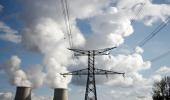The Indian government has come out with a nice name for its tried and tested 220MW pressurised heavy water reactor -- Bharat Small Reactor.

With the global nuclear power industry moving towards small modular reactors (SMR) and several types of such reactors are under development, there is also a need for uniformity in regulatory norms for faster deployment, said Indian and global experts.
Indian experts also said the harmonisation/standardisation of SMR norms will not impinge on the sovereignty of an individual nation's decisions nor it will be an entry barrier while looking at exports.
According to them the risks in the case of SMRs are far less than their traditional big units.
The International Atomic Energy Agency (IAEA) is also keen on developing uniform safety norms for SMRs.
According to the IAEA, there are over 80 SMR designs at different stages of development globally.
"Development of internationally recognised and accepted regulatory norms for SMRs is a welcome step. This will help deployment of such reactors. We already have such safety norms developed by IAEA for existing reactor types, and this move will be a logical evolution of the existing regime of internationally recognised norms," S S Bajaj, retired chairman of India's Atomic Energy Regulatory Board, said.
"The safety guidelines will more or less be the same for SMRs as that of the bigger reactors. But given its smaller size there may be some changes in the norms like the 'exclusive or buffer zone' -- the area surrounding the nuclear power plant where no human habitation is allowed," another nuclear industry expert not wanting to be named said.
According to the expert, in the case of bigger units, the buffer zone is about 1 km radius.
"In the case of SMRs the plant's boundary wall is where the buffer zone would end as the accidental damage -- even the extreme case of core meltdown will not be major given the reactor's much lower capacity," the expert added.
Small modular reactors are the ones which are factory-made compact with less than 300 MW capacity-generally one third of the traditional reactor's capacity.
IAEA said Russia and China are operating SMRs and other countries are preparing for their commissioning.
Some of them are undergoing pre-licensing or licensing reviews, while others completed these steps and have entered or are expected to enter commercial operation in this decade.
A larger deployment of different types of SMRs, including microreactors, is expected in 2030 and beyond, IAEA stated.
India has also decided to develop SMRs.
After several decades of their operation, the Indian government has come out with a nice name for its tried and tested 220MW pressurised heavy water reactor (PHWR) -- Bharat Small Reactor.
Presenting her seventh Union Budget, Finance Minister Nirmala Sitharaman said: 'Nuclear energy is expected to form a very significant part of the energy mix for Viksit Bharat.'
'Towards that pursuit, our government will partner with the private sector for 1. setting up Bharat Small Reactors; 2. Research & development of Bharat Small Modular Reactor, and 3. Research & development of newer technologies for nuclear energy. The R&D funding announced in the interim budget will be made available for this sector,' Sitharaman had said.
Indian nuclear power experts said the 220MW PHWR, though small in power capacity, is not a modular reactor.
Speaking at the Nuclear Harmonisation and Standardisation Initiative conference IAEA Director General Rafael Mariano Grossi said: 'The global deployment of SMRs will need a degree of regulatory convergence. We're not aiming at unison, as it's impossible, but without some degrees of concrete collaboration where we can leverage what others are doing, the business model of modularity and flexibility is simply not going to work."
According to IAEA, the NHSI, was set up because the global deployment of advanced reactors and particularly SMRs requires a standardised design to be licensed in several countries in order to be quick and efficient, and for developers to achieve economies of scale.
Harmonised regulatory approaches are also vital to enable fast and safe deployment of SMRs.
The components for SMRs may be mass produced in factories and installed at the plant sites making them economical compared to bigger units.
The SMRs can be used for electric and non-electric applications and are suitable for flexible operation.
Energy intensive industries like steel, chemical and others are also showing interest in SMRs in order to reduce their emission levels.
Venkatachari Jagannathan can be reached at venkatacharijagannathan@gmail.com
Feature Presentation: Aslam Hunani/Rediff.com










